How To Register Devices To Pavloc
When started, many programs require permission elevation (shield on the app icon), but actually they don't need the administrator privileges for their normal operation. For example, you can manually grant permissions for your users on the app folder in the ProgramFiles and/or registry keys used past the plan. Then when starting such a programme under not-admin user account, a UAC prompt will appear and the user volition exist required to enter an administrator countersign (if User Business relationship Control is enabled on the figurer). To bypass this mechanism, many users simple disable UAC or grant admin privileges to a user past adding a user account to the local grouping "Administrators". Of course, both methods are not prophylactic.
Contents:
- Why some Windows apps not run under standard users and crave administrator permissions?
- How to run a plan that requires admin privileges under standard user?
- How to Bypass UAC with RunAsInvoker in __COMPAT_LAYER?
- Enable RunAsInvoker Manner in the EXE File Manifest
Why some Windows apps not run nether standard users and require administrator permissions?
An app may need the ambassador privileges to alter some files (logs, configs, etc.) in its ain binder in the C:\Plan Files (x86)\SomeApp. By default, users don't take edit (write and modify) permissions on this directory. In order this program to work normally, the ambassador permissions are required. To solve this trouble, you accept to manually grant the alter and/or write permission for a user (or the congenital-in Users group) on the app binder at the NTFS file organization level.
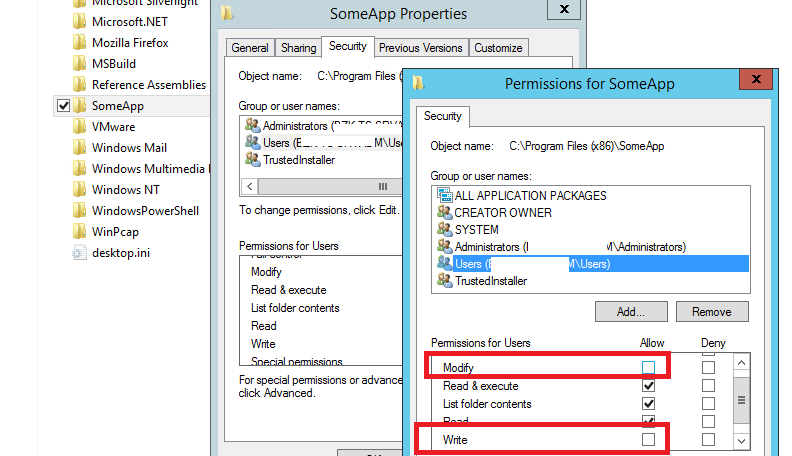
Note. Actually, it is non recommended to store the changing application data in its own folder nether C:\Program Files. It's better to store the app data in the user profile. But information technology is a question of laziness and incompetence of the app developers.
How to run a program that requires admin privileges under standard user?
Earlier nosotros described how to disable a UAC prompt for the sure app using RunAsInvoker parameter. However, this method is not flexible enough.
You lot can as well utilise RunAs with the saved administrator password (in the Windows Credentials Director) using the /SAVECRED choice. It is also insecure because the user can apply the saved ambassador credentials countersign to run any plan on this estimator.
Let's consider an easier mode to forcefulness any program to run without administrator privileges (without entering the admin password) and with UAC enabled (Level 4, 3 or two of the UAC slider).
Allow's take the Registry Editor every bit an example — regedit.exe (it is located in the C:\Windows\ binder). Detect the UAC shield next to the app icon. This icon means that elevation of privileges via UAC will be requested to run this program.
If you run regedit.exe, you volition see a User Account Control window asking for the administrator credentials (Do you want to allow this app to make changes to your device?). If yous do not provide a password and do not ostend elevation, the app won't start.
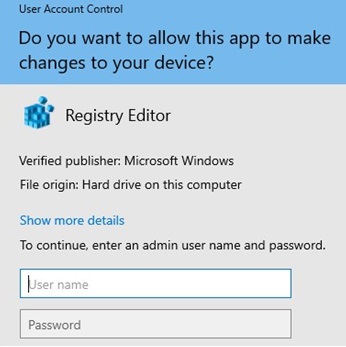
Let's try to bypass the UAC request for this program. Create the text file run-equally-non-admin.bat containing the post-obit lawmaking on your Desktop:
cmd /min /C "set __COMPAT_LAYER=RUNASINVOKER && start "" %1"
To force the regedit.exe to run without the ambassador privileges and to suppress the UAC prompt, simple drag the EXE file you desire to start to this BAT file on the desktop.
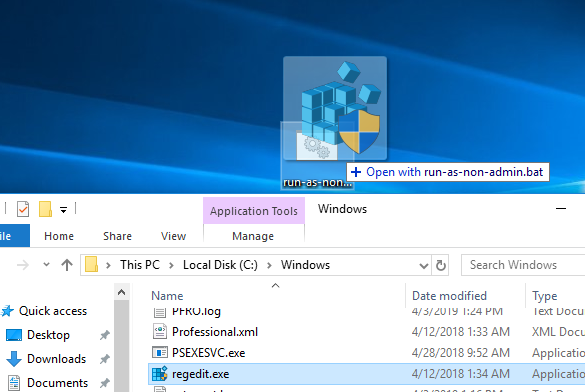
Then the Registry Editor should showtime without a UAC prompt and without inbound an administrator password. If you open the Chore Manager and add the Elevated column, you will see that there is the regedit.exe process without the elevated status (run with not-admin user permissions).

Endeavor to edit any parameter in the HKEY_LOCAL_MACHINE registry hive. As you can see, a user cannot edit the item in this registry cardinal (the user doesn't have write permissions to the organisation registry keys). But you lot can add or edit registry keys and parameters in your user hive — HKEY_CURRENT_USER.
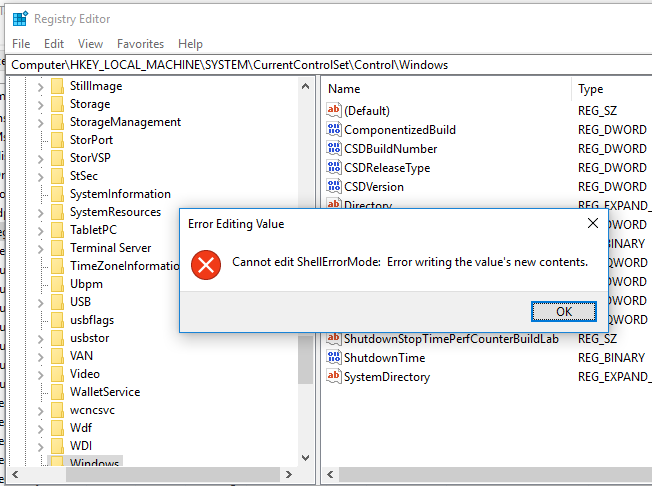
In the same way you lot tin run any app using the BAT file. Just specify the path to the executable file.
run-app-as-not-admin.bat
Set up ApplicationPath="C:\Program Files\SomeApp\testapp.exe"
cmd /min /C "set __COMPAT_LAYER=RUNASINVOKER && kickoff "" %ApplicationPath%"
You can likewise add a context menu that allows to run all apps without summit. To exercise it, create the RunAsUser.REG file, copy the post-obit lawmaking into it, save and import it into the Windows registry by double clicking on the reg file (yous will demand ambassador permissions to apply this change).
Windows Registry Editor Version 5.00 [HKEY_CLASSES_ROOT\*\shell\forcerunasinvoker] @="Run every bit user without UAC privilege elevation" [HKEY_CLASSES_ROOT\*\trounce\forcerunasinvoker\command] @="cmd /min /C \"fix __COMPAT_LAYER=RUNASINVOKER && beginning \"\" \"%1\"\""
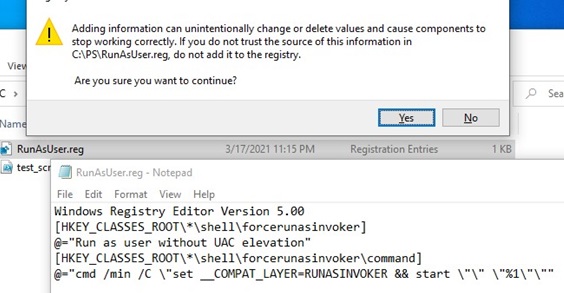
After that, to run any application without the ambassador privileges, just select "Run as user without UAC privilege elevation" in the context menu of File Explorer.
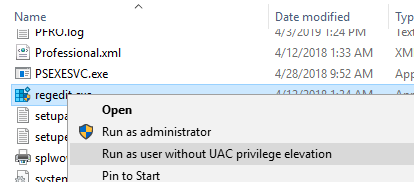
Let me remind you once more that using the program in the RUNASINVOKER mode won't allow y'all to elevate the plan. The RunAsInvoker suppresses UAC prompt and tells the plan that it should run with the permissions of the current user, and not ask for superlative of privileges. If a programme really needs elevated privileges to edit organization settings or files, information technology won't work or volition ask for admin permissions again.
How to Bypass UAC with RunAsInvoker in __COMPAT_LAYER?
The environs variable __COMPAT_LAYER allows yous to set dissimilar compatibility levels for the applications (the Compatibility tab in the properties of an EXE file). Using this variable, yous tin can specify the compatibility settings to exist used when starting a program. For instance, to beginning an app in Windows 8 compatibility mode and 640×480 resolution, set the following:
set __COMPAT_LAYER=Win8RTM 640x480
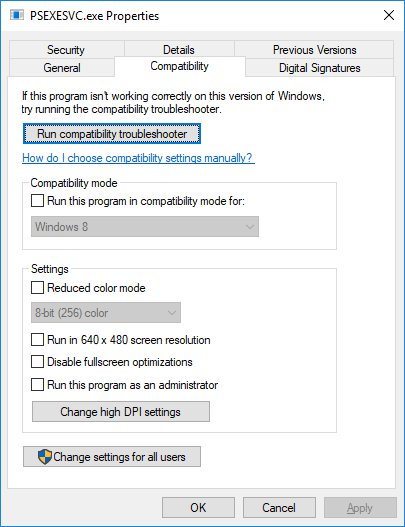
The __COMPAT_LAYER variable has some options nosotros are interested in. There are the following parameters:
- RunAsInvoker – run an app with the privileges of a parent process without the UAC prompt;
- RunAsHighest – run a program with the highest-level permission available to the user (the UAC prompt volition appear if a user has the administrator privileges);
- RunAsAdmin – run an app as ambassador (the UAC prompt appears each time).
It ways that the RunAsInvoker parameter doesn't provide the ambassador permissions, but only suppresses the UAC prompt.
The following CMD lawmaking enables the RunAsInvoker manner for the current process and runs the specified program without top:
set __COMPAT_LAYER=RUNASINVOKER
start "" "C:\Program Files\MyApp\testapp.exe"
Enable RunAsInvoker Mode in the EXE File Manifest
As we said higher up, Windows 10 displays a UAC shield icon for programs that require elevation to run. Developers gear up this requirement when compiling the application in the program manifest .
You can edit the manifest of any exe file and disable the requirement to run the programme in elevated manner.
To edit the program manifest, you can utilize the free Resource Hacker tool. Open up the executable file of the app in Resources Hacker.
In the tree on the left, get to the Manifest section and open the program manifest. Pay attending to the following xml section:
<requestedPrivileges> <requestedExecutionLevel level="requireAdministrator" uiAccess="false"/> </requestedPrivileges>
It is thank you to the requireAdministrator option that Windows always tries to run this program every bit an administrator.
Change requireAdministrator to asInvoker and the salvage changes in exe file.

Note that at present the UAC shield has disappeared from the program icon, and you tin run it without asking for administrator countersign with the current user permissions.
If the executable app file is signed with MS Authenticode (Lawmaking Signing certificate), then after modifying the exe file, it may cease working or issue a alarm.
In this example, you can force the program to use an external manifest file. Create a plain text file appname.exe.manifest (for example, Autologon.exe.manifest) in the directory with the exe file and copy the manifest code from Resources Hacker into it. Change requireAdministrator to asInvoker. Salve the manifest file.
To have Windows always try to apply the external manifest file when launching exe files, enable a special registry parameter:
REG ADD "HKLM\SOFTWARE\Microsoft\Windows\CurrentVersion\SideBySide" /v PreferExternalManifest /t REG_DWORD /d 1 /f
Restart Windows and make sure the program is using an external manifest file that says to run without administrator privileges.
Source: http://woshub.com/run-program-without-admin-password-and-bypass-uac-prompt/
Posted by: beattiehouseenjut.blogspot.com


0 Response to "How To Register Devices To Pavloc"
Post a Comment